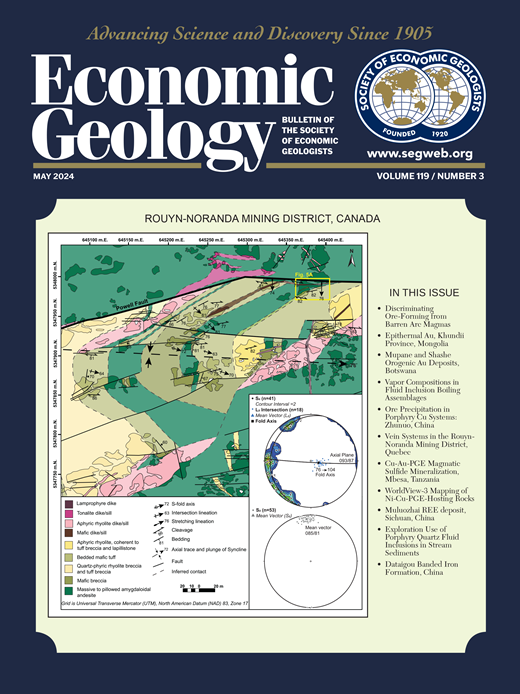阿拉斯加东部金牛座Cu-Mo地区火成岩和热液系统时空演化的年代学及填图约束
IF 4.9
1区 地球科学
Q1 GEOCHEMISTRY & GEOPHYSICS
引用次数: 1
摘要
金牛座斑岩铜钼区在阿拉斯加东部内陆包含四个矿化斑岩中心。这四个中心都是在大约72到67 Ma的岩浆期形成的,有7个不同的火成岩套。每一火成岩组都有热液蚀变和成矿作用,较年轻的脉冲叠加着较老的脉冲。每个岩浆-热液系统并不存在于所有四个矿化中心。除Dennison产状外,每个矿化中心均记录了重复的中硅岩浆活动及其相关的蚀变和矿化脉冲。激光烧蚀-电感耦合等离子体质谱U-Pb锆石结晶年龄表明,早期石英斑岩岩脉群年龄在71 ~ 70 Ma之间,与钾、绢云母和丙基蚀变有关。石英白云岩侵入体位于约69 Ma,表现为早期钠钙蚀变,并叠加有钾蚀变、绢云母蚀变和丙基蚀变。金牛座二长岩套由石英岩浆岩切割而成,但其侵位年龄约为70 Ma,显示出最大的钾质和绢云母蚀变足迹。长石斑岩岩脉就位时间约为69 Ma,具有明显的电气石含钾蚀变和绢云母蚀变。在这一套之后发育了一火成岩角砾岩,具有二长岩火成岩基质。钠钙蚀变与火成岩角化有关。少量二长岩于约68 Ma就位,造成局部普遍的绢云母-电气石-黄铁矿蚀变。该区最年轻的岩浆作用组为一系列花岗闪长斑岩岩脉,具有弱钠钙蚀变和丙基蚀变,截断了早期的蚀变组合。该区成矿由黄铜矿和辉钼矿伴生含钾长石和黑云母蚀变包体(A脉)的含糖石英脉组成。不太常见的带状石英辉钼矿脉(B脉)出现在钾长石包壳中。金分布在整个地区,与铜品位密切相关。绢云母蚀变铜含量较低,主要与绢云母包覆的石英-黄铁矿脉(D脉)有关。磁黄铁矿和局部毒砂存在于绢云母组合中。磁黄铁矿也以包裹体形式出现在D脉内的黄铁矿中。岩浆呈现氧化特征,磁铁矿丰富,钛矿稀少,锆石中Eu/Eu*和Ce/Ce*含量升高。锆石Th/U和Yb/Gd组成表明其分选路径受磷灰石、钛矿和角闪石控制。锆石稀土元素比值和微量元素数据表明,两批岩浆由基性母质成分演化为二长辉长岩和花岗闪长岩成分。在早期岩浆脉冲(约72 ~ 69 Ma)中,分异结晶是成矿的关键。早期,较好的矿化层演化为较少的负Eu异常(Eu/Eu* > 0.7),表明斜长石结晶受到抑制,这表明氧化程度较高,水压较高,而较晚的矿化层则较差。通过填图和U-Pb、Re-Os年代学确定了该区的时空演化。火成岩和热液组合的填图表明,侵入套和热液系统的位置随着时间的推移而发生了空间上的转移,这是基于高温(以钾硅酸盐为主)蚀变的存在,这与Cu和Au的最高品位相一致。最早的热液系统以Bluff和东金牛座为中心,在第二岩浆套就位时向西金牛座过渡。第3套岩浆层位在东金牛座后方,第4、5套岩浆层位在西金牛座后方。最新的地层分布广泛,没有高温蚀变的核心作为中心轨迹。东金牛座包含了7个岩浆和热液套中的6个的重叠,并且在该地区具有最高的相交等级和吨位。Bluff和Dennison产状火成岩套和热液组合较少,成矿作用弱。钠钙蚀变常见于斑岩系统的深部和远侧,仅在西金牛座出现,表明高盐度非岩浆流体的局部来源。本文章由计算机程序翻译,如有差异,请以英文原文为准。
Geochronology and Mapping Constraints on the Time-Space Evolution of the Igneous and Hydrothermal Systems in the Taurus Cu-Mo District, Eastern Alaska
The Taurus porphyry Cu-Mo district contains four mineralized porphyry centers in the eastern interior of Alaska. All four centers were emplaced during a magmatic episode that spanned from ca. 72 to 67 Ma, with seven distinct igneous suites. Each igneous suite resulted in hydrothermal alteration and mineralization, with younger pulses overprinting older pulses. Each magmatic-hydrothermal system is not present at all four mineralized centers. Apart from the Dennison occurrence, each mineralized center records pulses of repeated intermediate-silicic magmatism and associated alteration and mineralization.
Laser ablation-inductively coupled plasma-mass spectrometry U-Pb zircon crystallization ages indicate that an early quartz porphyry dike swarm ranges in age from ca. 71 to 70 Ma and is associated with potassic, sericitic, and propylitic alteration. Quartz latite intrusions were emplaced at ca. 69 Ma and exhibit early sodiccalcic alteration overprinted by potassic, sericitic, and propylitic alteration. The Taurus monzonite suite is cut by quartz latite but yielded an ca. 70 Ma emplacement age and exhibits the largest footprint of potassic and sericitic alteration. Feldspar porphyry dikes were emplaced ca. 69 Ma and have significant tourmaline-bearing potassic and sericitic alteration. This suite was followed by development of an igneous breccia with a monzonitic igneous matrix. Sodic-calcic alteration was associated with the igneous brecciation. A small stock of monzonite was emplaced at ca. 68 Ma causing locally pervasive sericite-tourmaline-pyrite alteration. The youngest suite of magmatism dated in the district is a series of granodiorite porphyry dikes with weak sodic-calcic and propylitic alteration that truncates earlier alteration assemblages.
Mineralization in the district consists of chalcopyrite and molybdenite associated with sugary quartz veins with potassium feldspar and biotite alteration envelopes (A veins). Less common banded quartz-molybdenite veins (B veins) occur with potassium feldspar envelopes. Gold occurs throughout the district and is strongly correlated with copper grade. Sericitic alteration contains lower copper contents and is predominantly associated with quartz-pyrite veins with sericite envelopes (D veins). Pyrrhotite and local arsenopyrite are present in sericitic assemblages. Pyrrhotite also occurs as inclusions in pyrite within D veins.
Magmas across the district exhibit oxidized characteristics, evidenced by the presence of abundant magnetite, rare titanite, and elevated Eu/Eu* and Ce/Ce* in zircon. Zircon Th/U and Yb/Gd compositions suggest a fractionation path controlled by apatite, titanite, and hornblende. Zircon rare earth element ratios and trace element data indicate two distinct batches of magma evolved from mafic parental compositions to monzonite and granodioritic compositions via fractional crystallization. In the early pulse of magma (ca. 72–69 Ma), fractional crystallization was key to ore formation. Earlier, better mineralized suites evolve to less negative Eu anomalies (Eu/Eu* > 0.7), indicating more oxidized and higher-water-pressure conditions evidenced by the suppression of plagioclase crystallization, compared to later, more poorly mineralized suites.
The temporal and spatial evolution of the district was determined from mapping and U-Pb and Re-Os geochronology. Mapping of igneous and hydrothermal assemblages indicates that the locus of the intrusive suites and hydrothermal systems shifted spatially over time, based on the presence of high-temperature (K-silicate–dominant) alteration, which is coincident with the highest Cu and Au grades. The earliest hydrothermal system was centered at Bluff and East Taurus and transitioned to West Taurus during emplacement of the second magmatic suite. Emplacement of the third magmatic suite was centered back at East Taurus, and the fourth and fifth suites were centered at West Taurus. The latest suites were widespread without a core of high-temperature alteration marking a central locus. East Taurus contains the overlap of six of the seven magmatic and hydrothermal suites and has the highest intersected grades and tonnages in the district. The Bluff and Dennison occurrences exhibit fewer igneous suites and hydrothermal assemblages with weak mineralization. Sodic-calcic alteration, common on the deep and distal flanks of porphyry systems, is only present at West Taurus and is indicative of a localized source of high-salinity nonmagmatic fluids.
求助全文
通过发布文献求助,成功后即可免费获取论文全文。
去求助
来源期刊

Economic Geology
地学-地球化学与地球物理
CiteScore
10.00
自引率
6.90%
发文量
120
审稿时长
6 months
期刊介绍:
The journal, now published semi-quarterly, was first published in 1905 by the Economic Geology Publishing Company (PUBCO), a not-for-profit company established for the purpose of publishing a periodical devoted to economic geology. On the founding of SEG in 1920, a cooperative arrangement between PUBCO and SEG made the journal the official organ of the Society, and PUBCO agreed to carry the Society''s name on the front cover under the heading "Bulletin of the Society of Economic Geologists". PUBCO and SEG continued to operate as cooperating but separate entities until 2001, when the Board of Directors of PUBCO and the Council of SEG, by unanimous consent, approved a formal agreement of merger. The former activities of the PUBCO Board of Directors are now carried out by a Publications Board, a new self-governing unit within SEG.
 求助内容:
求助内容: 应助结果提醒方式:
应助结果提醒方式:


